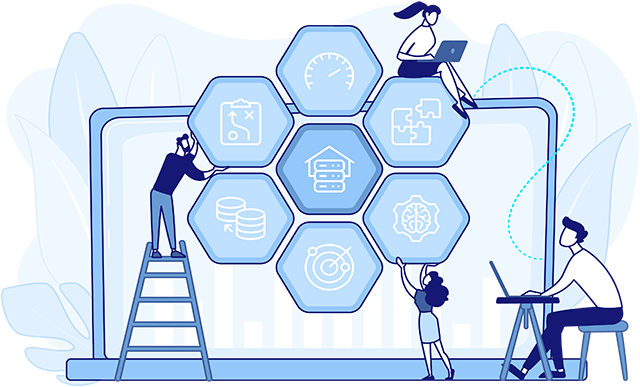The digital age has brought about numerous advancements, but it has also ushered in a new era of cyberthreats. While AI has been implemented as a tool to defend against cyberthreats, this double-edged sword has also been exploited by malicious actors to create new and more sophisticated cyberattacks than ever before
The digital age has brought about numerous advancements, but it has also ushered in a new era of cyberthreat security. While AI has been implemented as a tool to defend against cyberthreats, this double-edged sword has also been exploited by malicious actors to create new and more sophisticated cyberattacks than ever before.
In this article, we will delve into the nuances of AI-powered threats, examine the tactics employed by cybercriminals, and explore proactive cyberdefence strategies to safeguard against these evolving dangers.
The Rise of AI-Powered Cyberthreats
As AI technology has evolved, so too have the tactics of cybercriminals. Today, the very tool once used to fortify digital defences is being co-opted to create more complex and insidious cyberthreats. Malicious actors now deploy AI to craft personalised phishing schemes, develop adaptive malware that can evade detection, and even automate large-scale attacks. A study by CFO revealed that 85% of cybersecurity professionals report that the rise in cyberattacks can be attributed to AI. This shift underscores the urgent need for adaptive cybersecurity measures that can counter the growing challenge of combating AI-enhanced threats while continuing to leverage AI’s defensive capabilities.
Tactics Employed by Malicious Actors
Malicious actors use a variety of tactics to leverage AI and exploit vulnerabilities in systems. AI allows attackers to create attacks that are autonomous, adaptable, and difficult to detect. Understanding these methods is crucial for developing effective cyberdefence strategies. Some of the most common cyberattacks that have been enhanced by AI include:
Phishing and Spear Phishing: AI algorithms can analyse vast amounts of data to craft highly personalised and convincing phishing emails. These emails can mimic legitimate communications with remarkable accuracy, increasing the likelihood of recipients falling victim to the scam.
Malware and Ransomware: AI-driven malware and ransomware are designed to evade detection by traditional antivirus software. These malicious programs can modify their code on the fly, making it difficult for signature-based detection systems to identify them. AI can also be used to optimise the distribution of malware, ensuring it reaches the most vulnerable targets.
Social Engineering: AI can amplify social engineering attacks by gathering and analysing information about potential victims from social media and other online sources. This data can be used to create highly targeted attacks that exploit human psychology and social behaviours. For example, AI can simulate conversations that appear genuine, tricking individuals into divulging sensitive information or performing actions that compromise security.
Automated Exploits: AI can automate the discovery and exploitation of vulnerabilities in software and systems. These automated exploits can quickly scan for weaknesses and launch attacks without the need for human oversight. This increases the speed and scale at which cyberattacks can occur, overwhelming traditional security measures.
Proactive Cyberdefence Strategies
In the face of these advanced AI-driven threats, organisations must adopt proactive cyberdefence strategies. Reactive measures are no longer sufficient to protect against the sophisticated tactics employed by malicious actors.
Advanced Threat Detection
Implementing advanced threat detection systems that leverage AI and machine learning is crucial. These systems can analyse patterns and behaviours to identify anomalies that may indicate a cyberattack. By continuously learning from new data, AI-powered threat detection can stay ahead of evolving threats.
Continuous Monitoring and Response
A robust cybersecurity strategy includes continuous monitoring of networks and systems for signs of compromise. Security Operations Centres (SOCs), like Codestone’s CyberCare SOC, play a vital role in this. It provides real-time monitoring and incident response, ensuring that threats are detected and mitigated promptly. Codestone’s CyberCare SOC operates 24/7, combining AI, automation, and expert human oversight to swiftly detect, analyse, and resolve cyberthreats before they escalate
Employee Training and Awareness
Human error remains one of the weakest links in cybersecurity. Regular training and awareness programmes can equip employees with the knowledge to recognise and respond to potential threats. Simulated phishing attacks and other training exercises can help reinforce best practices and reduce the risk of successful social engineering attacks.
Threat Intelligence Integration
Integrating threat intelligence feeds into SOC operations enhances proactive defence capabilities. By leveraging up-to-date threat intelligence data, SOCs can anticipate emerging threats and adapt defences accordingly. This proactive stance ensures that organisations are prepared to defend against the latest cyberthreats before they manifest into attacks.
Cybersecurity Automation
Automating routine cybersecurity tasks within the SOC streamlines operations and improves response times. AI and automation technologies can handle repetitive tasks such as log analysis, threat prioritisation, and incident triage, allowing SOC analysts to focus on more complex security challenges and strategic initiatives.
Regular Security Audits and Penetration Testing
Conducting regular security audits and penetration testing can help identify vulnerabilities before they are exploited by malicious actors. These assessments should be performed by experienced professionals who can provide actionable insights and recommendations for improving security posture.
The Role of Codestone’s CyberCare SOC
Modern digital security demands a robust and proactive approach. Codestone’s CyberCare SOC serves as your central cyberdefence hub, managing risk, applying comprehensive protection, and providing peace of mind. Our CyberCare SOC operates around the clock, integrating advanced AI-powered tools and expert human oversight to monitor and respond to threats effectively. While AI accelerates threat detection and response, human analysts provide critical context, intuition, and decision-making that AI alone cannot replicate.
This combination ensures that Codestone’s SOC can keep pace with the constantly evolving and adapting abilities of AI cyberthreats, offering proactive defence measures that anticipate and mitigate emerging risks before they impact your organisation’s security posture. Whether it’s detecting anomalies in real time, automating incident response, or leveraging cutting-edge threat intelligence, Codestone’s CyberCare SOC ensures your organisation stays resilient against the evolving threat landscape.
Securing Your Organisation Against Future Cyberthreats
As AI continues to evolve, so too will its application in cyberattacks. The integration of AI into cybersecurity has transformed both defensive strategies and the nature of cyberthreats themselves. As organisations face increasingly sophisticated AI-driven attacks, the proactive adoption of advanced security measures, including robust threat detection, continuous monitoring, and AI-driven automation, is paramount. By partnering with Codestone, organisations can enhance their cyber resilience, mitigate risks, and protect their valuable assets from the ever-present threat of cybercrime.
Take the first step towards strengthening your defences with Codestone today.





